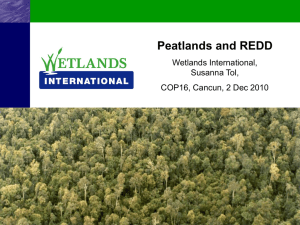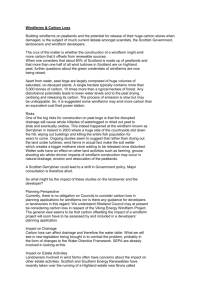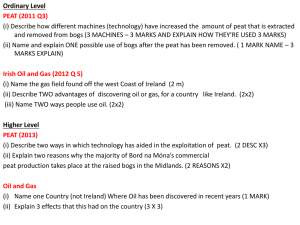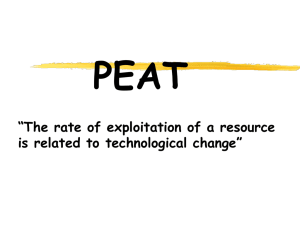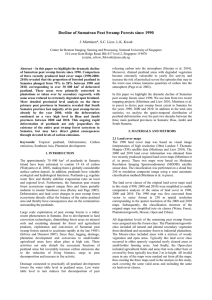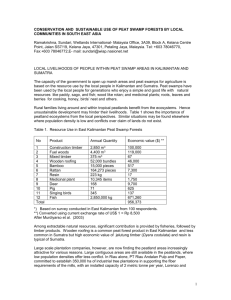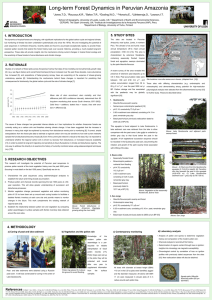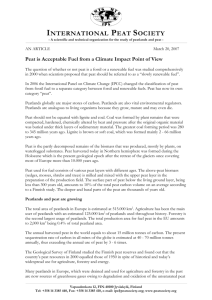Peatlands
advertisement
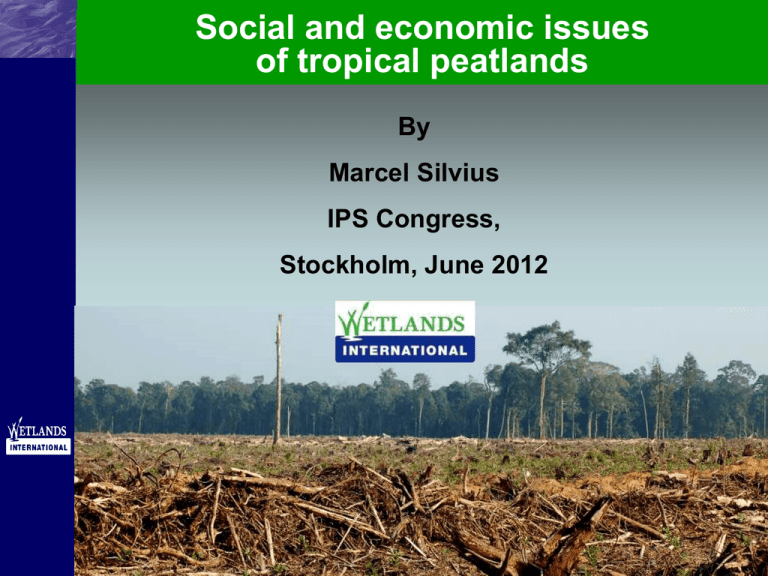
Social and economic issues of tropical peatlands By Marcel Silvius IPS Congress, Stockholm, June 2012 Tropical peat swamp forest Primary peat swamp forest Belait area, Brunei Peat swamp typical for atlantic forest of Brazil and countries of the Guyana shield Rio Preto, Sao Paulo, Brazil Peat swamp forest in Maputa land Southern Africa Peat swamp forest, St Lucia National Park, South Africa Sub-saharan Africa: Peat CO2 = 25% of all its fossil fuel CO2 Congo basin Key role in the water cycle • Globally 10% of all freshwater • Source areas of many rivers • Important for water storage and supply • Crucial for mitigation of droughts and floods High biodiversity Sebangau, Indonesia Berbak National Park, Sumatra, Indonesia) What makes peatlands so special? Peat: organic matter accumulated over thousands of years storing carbon in thick layers Tropical peat bogs are rain water fed Peat swamp forest River Mineral Soil Organic matter + 90% water River Drivers of peatland degradation in SE Asia • Poverty • Limited development options • Weak governance • • • • • Lack of awareness Competing sectors Lack of coherent policies Short-term profits versus long-term sustainability Corruption • Deforestation • Legal & illegal logging • Drainage • Grazing • Agriculture • Plantations (palm oil & pulp wood) Drainage causes main problems Uganda Peat drainage CO2 emissions In tropical conditions: 9,1 t CO2 ha-1 yr-1 per each 10 cm drainage depth 86 t CO2-eq ha-1 yr-1 for drainage depths of 60 – 85 cm CO2 CO2 Peat dome Globally degrading peatlands are hotspots of CO2 emissions USA 34t EU 174 Mt Russia 160 Mt 115 Mt Central Asia 25 Mt East Africa 1 Gt SE Asia International demand for palm oil: powerful international driver of peat degradation Crop Emission tCO2/TJ Fuel Emission tCO2/TJ Palm oil 600 Fuel oil 73 Berbak National park, Jambi, Indonesia Socio-economic impact of peatland fires on people Indonesian peatland fires of 1997/98: • 2,2 million ha peat forest burned • Hundred thousands of hospitalisations and outpatient treatments • Millions of working & school days lost • 30% of children under 5 have respiratory illnesses and stunted growth • Social & ethnic tensions • Vicious cycle of environmental degradation & overexploitation Economics of 1997/98 peat fires in Indonesia • 1,5 – 2,2 million ha peat swamp forest burned • 1108 flights cancelled in Indonesia, Singapore & Malaysia • Economic damage by smoke: > 1.4 billion US$ • Economic losses (tourism & timber) > 7 billion US$ • Large fires occur every year International tensions / political impacts Smog and smoke over SE-Asia © NASA TOMS 22 Oktober 1997 Indonesian peat smoke in Malaysia How to reduce peat emissions? Forest Biomass Peatland soil Forest Biomass Peatland soil Only through rehabilitation! Forest Biomass Peatland soil Rewetting of peatlands is essential Another long-term impact: Soil Subsidence Land conversion Sarawak From Miettienen et al 2011 Long-term soil subsidence Nether-lands Nether-lands: 300 years of peatland drainage: now half the country deep under sea level In the tropics subsidence goes 5-10 times faster!.... South-east Asia Many peatlands are coastal and 70% will under continued drainage become undrainable … Towards solutions Towards solutions Priorities for achieving reduction targets 1.Conservation: • No more conversion: undisturbed peatlands • Supply chains must exclude products from drained peatlands 2.Stop unsustainable land-use • Remove existing plantations shift to mineral soil areas • Climate smart land use for severely degraded soils 3. Rewetting • Restore peat soils and vegetation where possible Peatland Ecosystem Restoration • • • • Rewetting & reforestation Fire prevention & control Local economic development Sustainable finance Carbon markets Private sector • Policy embedding Ecosystem Restoration legislation REDD+ • Conserve remaining peatswamps Moratorium on conversion of peatlands Wetlands International dam building in major drainage channels. New improved techniques have been developed by KFCP • Rehabilitation projects in drained and degraded peatlands: aiming to bring water tables up to a level that peatswamp forest may be restored and carbon emissions stopped. Paludiculture: Rewetting + regreening + productive use of degraded peatlands Fire prevention & fighting May reduce up to 50% of emissions Public and private investment in Carbon sequestration & emission reduction Possibilities evolve rapidly VCS: Verified Carbon Standard – PRC: recognizes peat rewetting & conservation – WI methodology development CCBA: Climate, Community & Biodiversity standard • Legislation –Indonesia: • Moratorium • Ecosystem restoration concessions • Carbon management Community-based implementation Local stakeholders can & must benefit – Employment – Profit sharing – Micro-credits (Bio-rights www.wetlands.org/bio-rights) – Sustainable development in bufferzones – Build capacity of local NGOs and science institutes – Healthy environment Challenges • Competing interests between sectors • Intense competition for land + corruption • Secure hydrologically viable areas • Lack of a compliance carbon market • Immature legislation • Uncertain finance flows • From science to policy Key priorities • Prioritise conservation – conservation of remaining natural peat swamp – no expansion of drainage land-uses on peat • Facilitate climate smart investment – develop coherent policy and legislation – facilitate public and private investment in rehabilitation of degraded peatlands – ensure safeguards : CCBA and VCS criteria. • Remove unsustainable land-uses – establish cut-off point for unsustainable practices – require time-bound plans • act before the carbon store is gone • act before the drainage limit is reached ACT NOW ! More information on www.wetlands.org marcel.silvius@wetlands.org Thank y u We need to start a paradigm shift from unsustainable practices to conservation and rehabilitation

